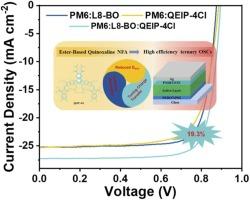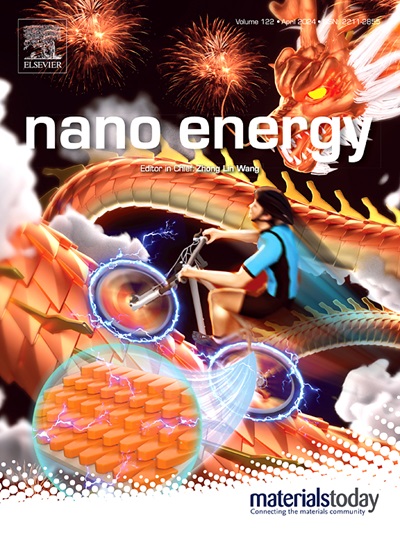Enhancing organic solar cell efficiency with ester-based quinoxaline non-fullerene acceptors in ternary blends
IF 17.1
1区 材料科学
Q1 CHEMISTRY, PHYSICAL
引用次数: 0
Abstract
The ternary strategy has been recognized as an effective approach for boosting the power conversion efficiency (PCE) of organic solar cells (OSCs). For ternary devices, selecting an appropriate third component is critical to ensure that both the photocurrent and voltage outputs of OSCs are not compromised. In this study, we present the use of an ester-based quinoxaline core non-fullerene acceptor (QEIP-4Cl) for the fabrication of ternary devices, which demonstrate enhanced absorption spectra and beneficial cascading LUMO energy level arrangement when paired with the PM6:L8-BO blend. Compared to the binary system, the ternary blend system exhibits superior thin-film phase separation and better suppression of non-radiative recombination, resulting in a reduced energy loss (Eloss) value. Moreover, by prolonging exciton lifetime, promoting charge carrier migration and suppressing charge recombination to facilitate improved JSC in OSCs. With the combined enhancement of VOC and JSC, OSCs achieve an impressive efficiency of 19.27 %. This research demonstrates the effectiveness of the ternary strategy in enhancing the performance of OSCs. The careful selection of the third component contributes to improved absorption, energy level alignment, and overall efficiency, making it a notable advancement in organic solar cell technology.

用酯基喹啉非富勒烯三元共混物受体提高有机太阳能电池效率
三元策略是提高有机太阳能电池功率转换效率的有效途径。对于三元器件,选择合适的第三元件对于确保OSCs的光电流和电压输出不受影响至关重要。在这项研究中,我们提出了使用基于酯的喹诺啉核心非富勒烯受体(QEIP-4Cl)来制造三元器件,当与PM6:L8-BO共混物配对时,该器件显示出增强的吸收光谱和有益的级联LUMO能级排列。与二元体系相比,三元共混体系表现出优越的薄膜相分离性能和更好的非辐射复合抑制能力,从而降低了能量损失(Eloss)值。此外,通过延长激子寿命、促进载流子迁移和抑制电荷复合来改善osc中的JSC。通过VOC和JSC的联合增强,osc的效率达到了19.27%。本研究证明了三元策略在提高osc性能方面的有效性。第三组分的精心选择有助于提高吸收,能级对齐和整体效率,使其成为有机太阳能电池技术的显着进步。
本文章由计算机程序翻译,如有差异,请以英文原文为准。
求助全文
约1分钟内获得全文
求助全文
来源期刊

Nano Energy
CHEMISTRY, PHYSICAL-NANOSCIENCE & NANOTECHNOLOGY
CiteScore
30.30
自引率
7.40%
发文量
1207
审稿时长
23 days
期刊介绍:
Nano Energy is a multidisciplinary, rapid-publication forum of original peer-reviewed contributions on the science and engineering of nanomaterials and nanodevices used in all forms of energy harvesting, conversion, storage, utilization and policy. Through its mixture of articles, reviews, communications, research news, and information on key developments, Nano Energy provides a comprehensive coverage of this exciting and dynamic field which joins nanoscience and nanotechnology with energy science. The journal is relevant to all those who are interested in nanomaterials solutions to the energy problem.
Nano Energy publishes original experimental and theoretical research on all aspects of energy-related research which utilizes nanomaterials and nanotechnology. Manuscripts of four types are considered: review articles which inform readers of the latest research and advances in energy science; rapid communications which feature exciting research breakthroughs in the field; full-length articles which report comprehensive research developments; and news and opinions which comment on topical issues or express views on the developments in related fields.
 求助内容:
求助内容: 应助结果提醒方式:
应助结果提醒方式:


